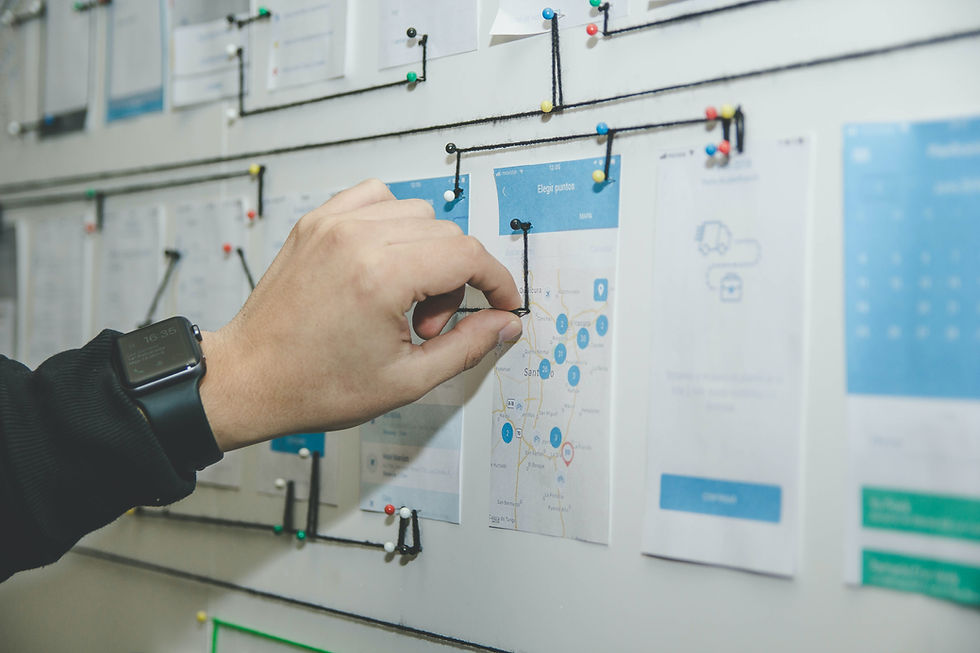Guiding the Journey: Why User Flows are Your Map to UX Success
- Arjun S S
- 4 days ago
- 3 min read

Imagine planning a road trip. You wouldn't just hop in the car and start driving aimlessly, would you? You'd likely map out your route, identify key stops, and understand the sequence of actions needed to reach your destination. In the world of User Experience (UX), user flows act as that crucial roadmap, guiding the user through your product or service to achieve their goals.
Think of a user flow as a visual representation of the path a user takes to complete a specific task within your website or app. It's a step-by-step journey, outlining every action they take, every decision they make, and every interaction they have along the way. Understanding and designing effective user flows is fundamental to creating intuitive, efficient, and ultimately satisfying experiences.
Why are User Flows So Important in UX?
Creating user flows might seem like an extra step, but it offers a wealth of benefits that directly impact the success of your product:
Clarity and Understanding: Visualizing the user's journey makes it easier for the entire team (designers, developers, stakeholders) to understand how users will interact with the product. This shared understanding fosters better collaboration and alignment.
Identifying Pain Points: By mapping out each step, you can pinpoint potential areas of friction, confusion, or frustration for the user. These "bottlenecks" can then be addressed proactively in the design.
Optimizing Efficiency: User flows help you streamline tasks and eliminate unnecessary steps, making the user's journey quicker and more efficient.
Ensuring Goal Completion: By focusing on the user's objectives, user flows ensure that the design effectively guides them towards achieving their desired outcome.
Consistency and Predictability: Well-defined user flows contribute to a consistent and predictable user experience across the product.
Identifying Edge Cases: Mapping out different user paths can help uncover less common but still important scenarios and edge cases that need to be considered in the design.
Foundation for Prototyping: User flows serve as a solid foundation for creating prototypes, ensuring that the interactive elements and navigation align with the intended user journey.
What Makes a Good User Flow?
Effective user flows share several key characteristics:
Clear Starting and Ending Points: Each flow should have a defined trigger (what initiates the user's journey) and a clear goal (the desired outcome).
Logical Sequence of Actions: The steps within the flow should follow a natural and intuitive progression.
Consideration of User Decisions: Flows should account for different choices users might make and the resulting paths they might take.
Visual Clarity: User flows are typically represented visually using diagrams with clear symbols and labels to indicate actions, decisions, and screens.
Focus on the User's Perspective: The flow should be designed from the user's point of view, focusing on their needs and goals.
Iterative Nature: User flows are not static. They should be reviewed, tested, and refined based on user feedback and evolving requirements.
Creating Your First User Flow: A Simple Approach
You don't need complex software to get started. Here's a basic approach:
Identify a Key Task: Choose a specific action a user will perform within your product (e.g., signing up for an account, adding a product to the cart, searching for information).
Determine the Entry Point: How will the user initiate this task? (e.g., clicking a button, navigating to a specific page).
Map Out the Steps: Break down the task into a sequence of individual actions the user will take and the screens they will interact with. Use simple shapes and arrows to represent these steps.
Include Decision Points: Identify any points where the user will need to make a choice and branch out the flow accordingly.
Define the Exit Point: What is the final outcome of the task? (e.g., successful signup, completed purchase, search results displayed).
Add Annotations (Optional but Helpful): Include notes to clarify specific actions, user thoughts, or potential issues.
Tools for Creating User Flows:
As you become more comfortable, you can explore various tools for creating more detailed and collaborative user flows, such as:
Figma/FigJam
Miro
Lucidchart
Sketch
Draw.io
In Conclusion:
User flows are more than just diagrams; they are powerful tools that help us empathize with our users, anticipate their needs, and design experiences that are both effective and enjoyable. By taking the time to map out the user's journey, we can identify potential roadblocks, optimize efficiency, and ultimately guide our users to success. So, before you dive deep into visual design, grab your virtual pen and start charting those crucial user paths – it's the roadmap to UX success you won't want to leave home without.



Comentarios